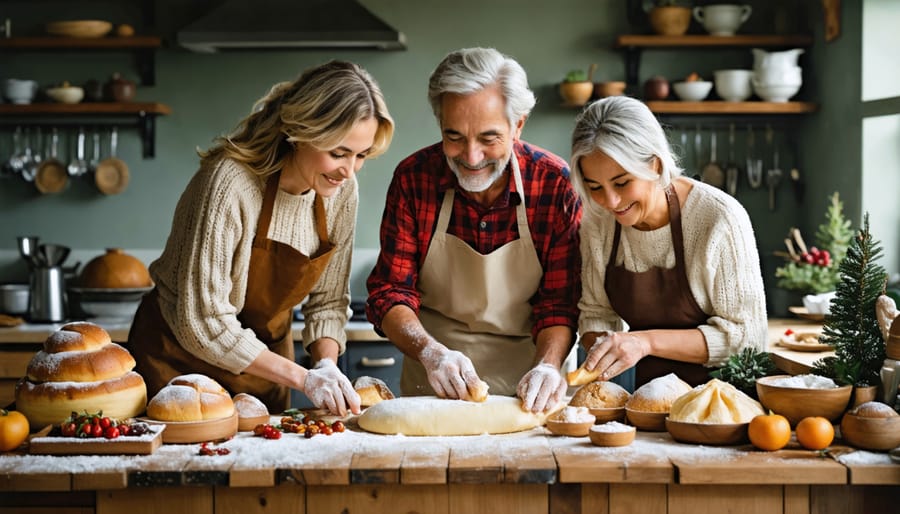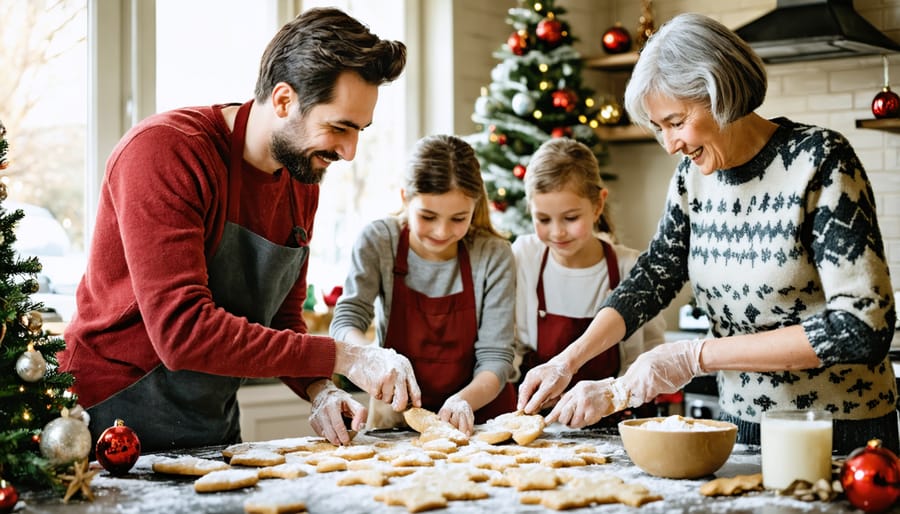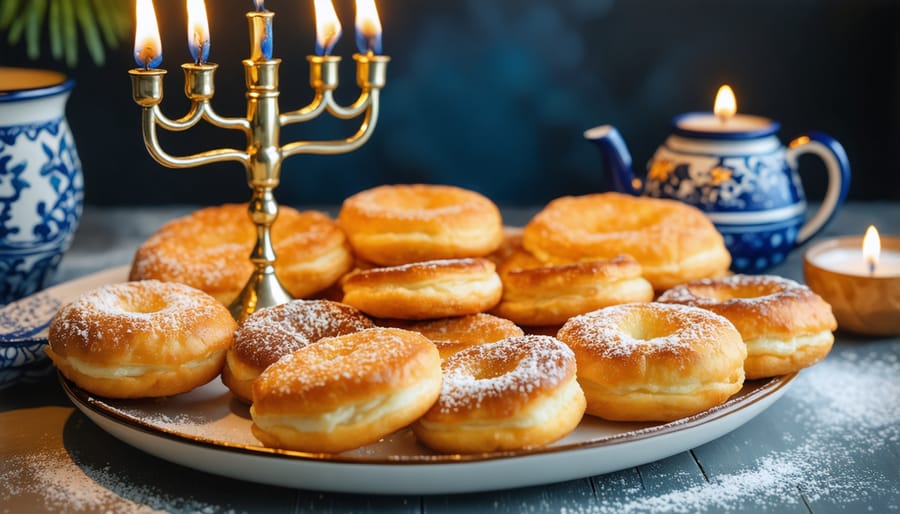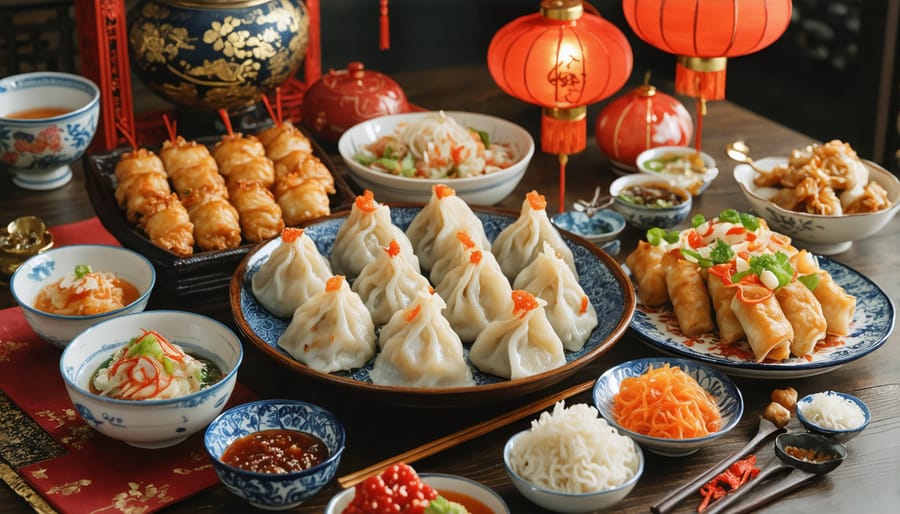
Gather your family’s cherished recipes and stories this holiday season, transforming them into a living legacy that celebrates your cultural identity through food and heritage. Every December, households worldwide illuminate with distinct traditions that span generations, each telling a unique story of belonging and celebration. From the aromatic spices of German lebkuchen to the rhythmic preparation of Mexican tamales, these cultural practices create the invisible threads that connect us to our ancestors and bind modern families together.
Whether you’re preserving age-old customs or crafting new ones, holiday traditions serve as anchors in our fast-paced world, offering moments of reflection and connection. They transform ordinary winter days into extraordinary memories, teaching children about their heritage while building bridges between different cultures. These shared experiences – whether lighting the menorah, preparing a feast for Chinese New Year, or baking Italian panettone – become the cornerstone of family identity and community belonging.
By embracing diverse holiday traditions, we not only honor our own heritage but also open our hearts to understanding and celebrating the rich tapestry of global celebrations that make this season truly magical.
The Magic of Christmas Kitchen Traditions
European Christmas Classics
The aroma of freshly baked holiday treats wafting through European homes is one of my favorite memories of celebrating across the continent. Among the most beloved German Christmas traditions is the iconic Stollen, a fruit-studded bread dusted with powdered sugar that’s said to represent baby Jesus wrapped in swaddling clothes. Every December, my German friend Lisa’s grandmother would spend days perfecting her family’s century-old recipe.
In Italy, no Christmas celebration is complete without Panettone, that gloriously tall, dome-shaped sweet bread that seems to defy gravity. Light and airy, with candied fruits and raisins scattered throughout, it’s traditionally shared with loved ones as a symbol of luck and prosperity for the coming year.
The British Christmas pudding holds a special place in holiday lore, with traditions dating back to medieval times. This dense, fruit-filled dessert is traditionally prepared on “Stir-up Sunday,” five weeks before Christmas, when family members take turns stirring the mixture and making a wish. The pudding is then aged, steamed on Christmas Day, and ceremoniously flambéed with brandy – creating a magical moment that never fails to draw gasps of delight from guests young and old.
What I love most about these European classics is how they bring families together, creating memories that span generations while filling our homes with the sweet scents of the season.
Modern American Holiday Tables
Today’s American holiday tables reflect our wonderfully diverse society while still honoring cherished traditions. The classic roast turkey remains a centerpiece in many homes, but modern families are increasingly adding their own creative twists. You’ll often find honey-glazed ham sharing space with grandmother’s traditional stuffing, or a beautifully brined turkey alongside contemporary sides like quinoa salad and roasted Brussels sprouts with bacon.
Many families now embrace a potluck-style gathering, where each guest brings their signature dish, creating an eclectic feast that tells the story of their combined heritage. Plant-based options have also found their way onto holiday tables, with dishes like mushroom Wellington or lentil loaf catering to vegetarian and vegan guests.
Dessert tables have evolved beyond just pumpkin pie, though it remains a beloved classic. You might spot trendy additions like chocolate-bourbon pecan pie, cranberry cheesecake, or artisanal cookie platters featuring global flavors like cardamom or matcha.
The beverage selection has expanded too, with craft cocktails and mocktails joining traditional eggnog and mulled wine. Many hosts create interactive drink stations where guests can customize their beverages with various garnishes and mix-ins.
What makes today’s holiday tables truly special is how they embrace both tradition and innovation, creating celebrations that feel both familiar and fresh. It’s about making everyone feel welcome while creating new memories that will become tomorrow’s traditions.

Hanukkah’s Delicious Heritage

Beyond Latkes
While latkes might be the star of many Hanukkah celebrations, the Festival of Lights offers a delicious array of traditional dishes that each tell their own story of miracle and perseverance. Growing up in my grandmother’s kitchen, I learned that every oil-fried delicacy we prepared carried centuries of meaning and memory.
Sufganiyot, those pillowy jelly doughnuts dusted with powdered sugar, represent the same miracle of oil as latkes but bring a sweeter dimension to the celebration. In recent years, I’ve seen creative bakers elevate these traditional treats with modern fillings like dulce de leche and chocolate-hazelnut spread, proving that traditions can evolve while keeping their core meaning intact.
Many Sephardic families celebrate with buñuelos, crispy fritters drizzled with warm honey or sugar syrup. These light-as-air puffs remind us that holiday food can be both meaningful and playful. In Morocco, sfenj – ring-shaped doughnuts – bring families together around the kitchen, where the art of dough-making becomes a cherished ritual passed down through generations.
For those seeking something beyond fried foods, rugelach makes a perfect addition to any Hanukkah spread. These delicate pastries, filled with nuts, chocolate, or fruit preserves, might not be fried in oil, but they’ve become an beloved part of many families’ holiday traditions.
Don’t forget about the symbolic dairy dishes! This custom honors the brave actions of Judith, who, according to tradition, served salty cheese to a general, making him thirsty enough to drink wine until he fell asleep. This led to a crucial victory for the Jewish people, and we celebrate with cheese-filled delicacies like cheese blintzes and cream cheese-topped noodle kugel.
Creating your own Hanukkah food traditions doesn’t mean you have to stick strictly to the classics. Many modern families combine traditional elements with contemporary twists – think sweet potato latkes with curry aioli or za’atar-spiced sufganiyot. The key is keeping the spirit of the holiday alive while making it personally meaningful for your family.
Lunar New Year Feasts
Lucky Foods and Their Meanings
In Asian cultures, the symbolism behind holiday foods runs as deep as family traditions themselves. During Lunar New Year, long noodles represent longevity – the longer the noodle, the longer the life! I remember my grandmother insisting we never break these noodles while eating, a superstition I still honor today.
Dumplings hold special significance in Chinese celebrations, their shape reminiscent of ancient gold ingots, symbolizing prosperity and wealth. In Japan, mochi (sweet rice cakes) are essential during New Year celebrations, with their stretchy texture representing flexibility and resilience in the year ahead.
Vietnamese Bánh Tét, cylindrical sticky rice cakes wrapped in banana leaves, represent family unity and earth’s bounty. The sticky texture symbolizes how family members should stick together, while the green wrapping represents nature’s protection.
Korean celebrations often feature rice cake soup (Tteokguk), with the white color symbolizing purity and new beginnings. Each bowl consumed traditionally represents gaining another year of wisdom.
These lucky foods aren’t just about symbolism – they’re about gathering family and passing down stories. Whether it’s the satisfying crunch of Korean sweet rice crackers or the warmth of Chinese eight treasures tea, each dish carries centuries of hopes, wishes, and blessings for the coming year.
Remember, incorporating these traditions into your own celebrations doesn’t require strict authenticity – it’s about embracing the spirit of good fortune and creating meaningful moments with loved ones.

Family Recipes Through Generations
There’s something magical about watching my grandmother’s hands work through a well-worn recipe card, her fingers tracing the faded handwriting of her own mother. These cherished family recipes are more than just instructions – they’re time capsules of love, tradition, and heritage passed down through generations.
In many families, recipe collections tell stories of immigration, adaptation, and celebration. My friend Maria still uses her great-grandmother’s handwritten cookbook, brought over from Italy in 1923, complete with splatter marks and margin notes that span decades. These recipes aren’t just about measurements and ingredients; they’re about preserving family history and cultural identity.
Today’s families are finding creative ways to maintain these culinary traditions while adapting to modern life. Digital recipe archives, family cookbooks, and cooking sessions recorded on video help ensure these precious instructions aren’t lost to time. Some families host annual cooking days where multiple generations gather to learn traditional techniques, sharing stories and creating memories while preparing holiday favorites.
The key to preserving family recipes is making them accessible and relevant for future generations. Consider documenting not just the ingredients and steps, but also the stories behind each dish – why it’s special, when it was traditionally served, and how it’s evolved over time. These details transform simple recipes into treasured family heirlooms that connect past, present, and future generations through the universal language of food.
Creating Your Own Food Traditions
Blending Old and New
Traditions have a beautiful way of connecting us to our past, but they can also evolve to reflect our present lives. As families grow and change, finding the sweet spot between honoring heritage and creating new memories becomes an art form. The key is to identify the heart of your cherished traditions and find creative ways to adapt them for today’s lifestyle.
Consider starting with your family’s most meaningful ritual and giving it a modern twist. If your grandmother always made traditional pierogi by hand, try hosting a pierogi-making party where friends bring their own family recipes to share. This not only preserves the original tradition but adds a social element that resonates with today’s gathering-focused culture.
Digital elements can beautifully complement traditional celebrations. Create a family recipe digital cookbook where each generation adds their own festive twists on classic dishes, or start a shared photo album where relatives across the globe can contribute pictures of their celebrations in real-time.
Don’t be afraid to mix cultural elements if your family has diverse heritage. Perhaps you’ll serve latkes alongside turkey, or combine German advent calendars with Chinese New Year decorations. The beauty lies in creating traditions that authentically represent your family’s unique story.
Remember that new traditions don’t diminish old ones – they enhance them. Whether it’s adding a modern gratitude practice to your traditional feast or incorporating eco-friendly versions of conventional decorations, these adaptations keep our celebrations relevant while honoring their roots. The most meaningful traditions are often those that grow and change with us while keeping the essential spirit alive.
Making Memories in the Kitchen
The kitchen has always been the heart of holiday celebrations, where the magic of tradition meets the warmth of family connection. Creating memories alongside loved ones while preparing special dishes is a gift that keeps giving through generations. Whether you’re recreating treasured family recipes or starting new traditions, involving everyone makes the experience more meaningful.
Start by assigning age-appropriate tasks to family members. Little ones can help measure ingredients or decorate cookies, while teens might enjoy learning the techniques behind more complex dishes. Document these precious moments by taking photos or recording video tutorials of grandparents sharing their cooking secrets.
Create a family recipe journal where everyone can contribute their favorite holiday dishes, complete with personal notes and memories. Make it interactive by hosting annual cookie-decorating parties or organizing a friendly competition for the best new holiday treat.
Don’t forget to embrace the mishaps – sometimes the burned cookies or the slightly-too-salty soup become the most cherished stories shared year after year. Set up a dedicated time for “kitchen lessons” where older generations can teach younger ones their specialty dishes, ensuring these culinary traditions continue.
Remember, it’s not just about the food; it’s about the laughter, stories, and bonds formed while creating it together. These kitchen moments become the threads that weave your family’s unique holiday tapestry.
As we gather around holiday tables year after year, we’re doing more than simply sharing meals – we’re weaving the fabric of our family stories and cultural heritage. These cherished food traditions serve as bridges, connecting us not only to our ancestors but also to future generations who will carry these customs forward.
I’m reminded of my own grandmother’s pierogi-making sessions, where three generations would gather in her tiny kitchen, sharing stories and laughter while crafting those perfect little dumplings. These moments weren’t just about food; they were about belonging, about understanding who we are and where we come from.
In today’s fast-paced world, maintaining these culinary traditions becomes even more significant. They offer us a chance to slow down, connect, and create lasting memories with our loved ones. Whether it’s teaching your children to make tamales during Las Posadas, preparing a traditional Lunar New Year feast, or baking Christmas cookies from a decades-old family recipe, these experiences shape our cultural identity and strengthen family bonds.
Remember, traditions don’t have to be grand or complex to be meaningful. Sometimes the simplest customs – like always serving Aunt Mary’s cranberry sauce or letting the kids decorate the holiday table – become the most treasured rituals. By embracing and adapting these food traditions, we ensure that our cultural heritage remains alive and vibrant for generations to come.



